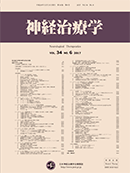33 巻, 1 号
選択された号の論文の16件中1~16を表示しています
- |<
- <
- 1
- >
- >|
-
2016 年33 巻1 号 p. 1
発行日: 2016年
公開日: 2016/05/20
PDF形式でダウンロード (151K) -
2016 年33 巻1 号 p. 2-4
発行日: 2016年
公開日: 2016/05/20
PDF形式でダウンロード (451K)
Editorial(論説)
-
2016 年33 巻1 号 p. 5-6
発行日: 2016年
公開日: 2016/05/20
PDF形式でダウンロード (270K)
特集 自己免疫性脳症の診断・病態・治療
-
2016 年33 巻1 号 p. 7-8
発行日: 2016年
公開日: 2016/05/20
PDF形式でダウンロード (309K) -
2016 年33 巻1 号 p. 9-18
発行日: 2016年
公開日: 2016/05/20
PDF形式でダウンロード (621K) -
2016 年33 巻1 号 p. 19-26
発行日: 2016年
公開日: 2016/05/20
PDF形式でダウンロード (988K) -
2016 年33 巻1 号 p. 27-31
発行日: 2016年
公開日: 2016/05/20
PDF形式でダウンロード (416K) -
2016 年33 巻1 号 p. 32-39
発行日: 2016年
公開日: 2016/05/20
PDF形式でダウンロード (4147K) -
2016 年33 巻1 号 p. 40-45
発行日: 2016年
公開日: 2016/05/20
PDF形式でダウンロード (1033K)
原著
-
2016 年33 巻1 号 p. 46-52
発行日: 2016年
公開日: 2016/05/20
PDF形式でダウンロード (1307K) -
2016 年33 巻1 号 p. 53-56
発行日: 2016年
公開日: 2016/05/20
PDF形式でダウンロード (475K)
神経治療最前線 海外学会参加報告
-
2016 年33 巻1 号 p. 57-59
発行日: 2016年
公開日: 2016/05/20
PDF形式でダウンロード (2715K)
-
2016 年33 巻1 号 p. 60-63
発行日: 2016年
公開日: 2016/05/20
PDF形式でダウンロード (313K) -
2016 年33 巻1 号 p. 65
発行日: 2016年
公開日: 2016/05/20
PDF形式でダウンロード (251K) -
2016 年33 巻1 号 p. 66
発行日: 2016年
公開日: 2016/05/20
PDF形式でダウンロード (242K) -
2016 年33 巻1 号 p. I1
発行日: 2016年
公開日: 2016/05/20
PDF形式でダウンロード (102K)
- |<
- <
- 1
- >
- >|
